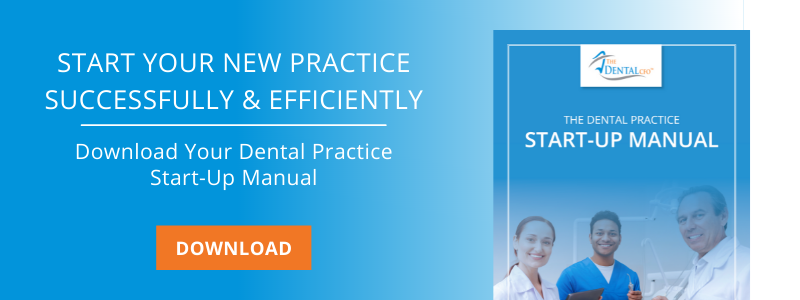AUTHOR: The Dental CFO
May 09, 2022
Opening a dental practice is much more involved than purchasing equipment, hiring a few people, and simply opening your doors. There is much to consider and plan for, especially in regard to cash flow. The American Dental Association suggests the average initial investment to start a practice is $500,000, which includes office construction, securing office equipment and dental supplies, paying employees, marketing expenses, and even legal consultation fees. This number varies greatly depending on location, owning versus renting your space, and the size of your practice – regarding square footage and the number of employees.

But before you even begin this process, you’ll want to dive into projected expenses and future revenue to make certain you have the capital to get started. Even if you have patients lined up, the billing process will take time, and during that time, you’ll need to meet vendor requirements and pay your staff. Before it gets to be too much, consider these tips and strategies.
Create a Pro Forma Budget (Cash Flow Projection)
First, what is a cash flow projection?
A cash flow projection is the breakdown of anticipated cash flowing into the business and the cash going out over time. You need to make sure you have cash on hand when it’s time for payroll and bills.
What is a pro forma budget?
A pro forma budget is a cash flow projection based on potential future scenarios. It’s a best practice to create various “what-if” scenarios to help you plan for the future. You can create “most likely,” “best,” and “worst” case scenarios. You can project your financial outlook if you hire new team members or take on a business loan, etc. By looking at different scenarios, you’ll be more prepared for whatever life throws your way. Plus, many banks require a pro forma to assess future financial stability when applying for a loan or credit line.
What expenses should I consider?
Before opening your first dental practice, you should outline the anticipated costs for the business. There are those initial one-time costs we mentioned earlier – office construction, office equipment and initial supplies, legal consultation fees, etc. – but then take a look at expected monthly fixed and variable overhead expenses. This will help you plan financially to make certain you have the cash needed on hand to get through those initial months when business is still ramping up.
What should you consider when it comes to a budget when opening a dental practice? A dental practice budget typically includes the following categories:
- Payroll – This is typically the largest expense for dental practices, sometimes requiring over 20 percent of your budget. It includes costs related to employee wages, as well as training, employee incentives, workers’ compensation insurance, and malpractice insurance.
- Facility – the location of your dental practice plays a role here. This may include rent or a mortgage payment. It also includes factors such as building insurance, maintenance expenses, taxes, and other associated costs.
- Supplies – All dental practices will need to purchase medical and office supplies. Look for reliable providers offering competitive pricing.
- Lab work – You will have variable hard costs when you outsource the production of dentures, crowns, bridges, and orthodontic products that you prescribe to your patients. While you can shop around, it may be more beneficial to focus efforts on patient volume. But lab work is an expense you must be mindful of that cuts into your profit margin.
- Office/General/Administrative – Your practice will have some recurring and as-needed general office expenses including bank fees, merchant fees, data and software, licenses and permits, accounting and payroll service fees, phone/internet/cable, insurance, etc. Determine what you know for sure and then earmark an additional amount for those unexpected, but needed, expenses that could occur.
- Marketing – Especially if you’re opening a brand new practice and you’re not known in your community, you’ll want to invest in marketing to drive awareness and patient traffic. Potential marketing costs include, but aren’t limited to, mailers and postage, website design and updates, digital and traditional advertising, and perhaps partnering with a marketing company for strategic guidance and execution.
This dental office overhead breakdown is simply the start of the process and may not account for all of your expected costs.
Start-Up Expenses
As you work to develop your dental practice financial model, you’ll need to consider the financial responsibility of building or purchasing space for your practice. You’ll need to plan for this expense early on and determine what’s best for your organization. Here are some factors that play a role in this:
- Region – Where your business is located will greatly impact cost. This is one of the first considerations – assessing the real estate market, along with the dental competition in the area.
- Square footage – The amount of space dedicated to your business is also a contributing factor. If you choose a larger location, expect a higher cost.
- Rental overhead – Are you paying rent? In addition, you’ll be paying costs like commercial liability insurance.
- Permits – Permitting can vary from city to city. Some locations are more business-minded and keep these costs lower.
- Supplies – The initial purchase of supplies will be costly, but this can be financed. Over time, this cost won’t hit all at once and will be easier to predict.
- Initial utility fees – In addition to your first month, you may have to pay deposits or setup fees.
- Equipment purchases or rentals – Assess the cost differences today and long-term consequences of buying versus renting. Make a decision that works best for your financial situation.
- Lab costs – Setting up a service with a lab may require a fee or consultation. Then, you’ll pay per-need or ongoing costs.
- Administrative costs – This includes costs associated with training your employees. While it will take time and money, this is not an area that should be cut.
- ADA accessibility – Most locations will need to have wheelchair ramps, ADA-accessible bathroom stalls, and other ADA requirements in place. Make sure you and your contractor are aware of these requirements and associated costs up-front to avoid future compliance issues and corrective costs.
- Compliance and regulatory requirements – Typically, this includes taking steps to meet OSHA requirements, along with having necessary sanitary equipment, supplies, and employee training.
Another part of the start-up process is factoring in the costs associated with hiring your team. You’ll need to hire them – which takes time and marketing, get them on payroll for your practice – which means hiring a payroll professional, whether internal or contract, and setting up training. And when hiring, you need to make certain job descriptions are accurate and clearly written and contracts and compensation packages meet compliance and legal criteria. It’s expensive to hire, and even more expensive to fire and/or rehire.
Consider which positions you need to hire for (and the typical local wages for each). The following are common dental practice roles:
- Dental hygienists
- Dental assistants
- Office managers
- Treatment coordinators and front desk receptionists
- Bookkeeper or CPA
- Assistant dentist
- Oral surgeon
- Lab technician
Labor Costs
Labor costs are higher than ever due to the COVID-19 pandemic. Carefully consider the number of dental assistants, hygienists, and other staff your practice needs right away. You don’t want to over-hire. The dental industry benchmark is that personnel (team) costs are 24 to 28 percent of your practice’s income. That’s a large component of the costs you’ll be paying out and a critical factor to consider when creating a cash flow or pro forma budget.
Consider hiring part-time employees as one way to keep costs down. You can build up hours, in most cases, over time as the practice grows. Also, cross-train employees so they can do more than one task, helping to reduce overall costs.
Additional Revenue Streams
As you work to build an understanding of the money going out, it’s also important to consider the money that’s coming into your practice and ways to boost this amount. For example, are there any high-profit procedures you can offer within your location that may bring people in and allow you to increase the amount you’re earning per client?
Another opportunity may be to incorporate a subscription package. Initially, this may look like savings for the patient, but subscriptions can help you get people back in for additional treatments, whether those are cosmetic or needed procedures.
Marketing Expenses
The next factor to consider is your marketing cost. This isn’t necessarily a fixed cost as it can change based on your need for brand awareness and new clients. Hiring a marketing agency is often the best route to take as it may cost less than employing someone within your practice to do this work for you. You can choose an in-house staff member to manage your marketing initiatives, but you’ll need to ensure they have the skills, the time, and the budget to see positive results. Marketing has many different components – it is rare to find one person skilled in all areas.
Consider the costs of establishing your practice online as well. Digital marketing fees typically include:
- The cost of a website
- Paid ads and social media
- SEO (search engine optimization)
- Pay-per-click advertising
- Direct mailings to the local community
Before you even dive into marketing, you’ll need to define your brand identity – what’s your practice name, logo, color scheme, fonts, brand voice, etc. What makes you stand out among your competitors? Defining this up front will make your marketing efforts much easier moving forward and will help with establishing a recognizable and memorable brand for patients.
In Conclusion
Finances can be stressful. There are so many costs and considerations and unknowns when starting your dental practice. Getting started is all about planning. In-depth preparation for your practice sets you up for success. It also reduces negative experiences by your future employees and patients.
The dental industry has many unique components. For example, you’ll need to meet compliance and regulatory oversight. And there are tax deductions and incentives only a dental industry professional will know. While you need to practice as a dentist, you need to run your practice as a business.
The Dental CFO can help you start off on the right path. We specialize in the dental industry, offering our clients dental industry expertise across all functions of the business. We offer a range of services to address the most common needs of a start-up dental practice, including tax planning and optimization, human resources, start-up assistance, and practice management. Our clients typically perform better than the national average. Find out how The Dental CFO can support your new business with a free consultation today.
